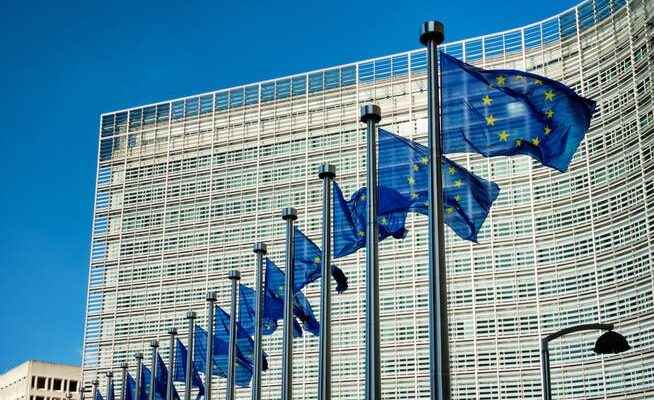The EU has big plans militarily. She wants to strengthen cyber defense and promote joint armament projects. It will start a training program for around 15,000 soldiers next week and is financing arms deliveries to Kyiv.
In view of the Russian threat, the EU states have undertaken to invest more money in their military and defense industry. Brussels does not want to be sidelined in this development.
It was a telling scene that took place in Brussels’ Berlaymont building on Thursday. Four EU commissioners stood in front of the microphones in the press room. Denmark’s Margrethe Vestager, Spain’s Josep Borrell, France’s Thierry Breton and Romania’s Adina Valean solemnly presented their latest security and defense plans – including a strategy to protect against cyber attacks and an action plan on “military mobility”.
But they were not prepared for the first critical question from a journalist. Whether the EU also took measures for its employees who had set out for the COP 27 climate conference in Sharm al-Sheikh, a “Politico” reporter wanted to know. The Egyptian government invited all delegates to download an official smartphone app that security advisors had exposed as a kind of “cyber weapon”. With it, the hosts are able to read all private e-mails, contacts and voice messages.
The four commission members exchanged embarrassed looks, but nobody wanted to answer the question. Once again reality seemed to have caught up with the EU executive, despite the fact that for months it has been feverishly launching programs aimed at some form of “building resilience” and being able to protect itself against all sorts of threats.
Digital counterattacks desired
The cyber defense program and the “military mobility” plan are the latest responses from Brussels to the changed geopolitical situation. In the cyber area, the Commission is not only proposing closer cooperation between the Member States in containing digital attacks. It also calls on countries to invest “in the full spectrum of cyber defense capabilities,” including “active defense capabilities.”
In plain language, this means encouraging digital counterattacks – so-called hackbacks, in which the attacked side paralyzes the attacker’s computer systems or other parts of their critical infrastructure. In Germany, however, where there is fear of the risk of an escalation, such a counterattack is viewed critically. The traffic light coalition has rejected it so far.
The Commission’s second initiative aims to ensure that soldiers and tanks can be relocated across borders more quickly within the EU. The Commission wants to comprehensively review the current military transport network and accelerate administrative procedures for the logistics of the armed forces in order to be able to act quickly in an emergency, as it announced. Such a program to create a “military Schengen area” has long existed in Brussels, it is part of the Pesco defense initiative.
No shortage of projects
In fact, there is no shortage of EU programs for armaments and defense projects. In addition, foreign military missions (with dubious success in some cases) have also been part of the portfolio of the international community for many years. So far, however, a real common security and defense policy has only existed on paper. After all, most EU countries organize their defense within the framework of NATO anyway.
With the war in Ukraine, however, things have started to move. In the face of the Russian threat, EU countries have pledged to invest more money in their military and defense industries, and Brussels does not want to be left out of this development. You have to make a “quantum leap forward” according to the “Strategic Compass”, the EU’s security policy document published in spring. Borrell, the foreign affairs representative, believes that without “hard power”, that is, without military clout, the rest of the world will not take you seriously.
But what exactly has the EU to show so far apart from the announcement that it will provide a new intervention force with 5,000 soldiers? As early as 2004, a comparable formation was set up in the form of the (until now unemployed) «battle groups».
The two most impressive recent projects are directly related to Ukraine. One is the joint procurement of armaments for the attacked country, financed through the so-called European Peace Facility. This fund was originally intended to help African partner countries that cannot afford to buy arms in Europe. The fund is endowed with 5.7 billion euros, and it is not part of the regular EU budget, which expressly excludes financing of military projects.
No power, just a moderator
The second is a training mission for around 15,000 Ukrainian soldiers, which is also funded by the Peace Facility. The training program EUMAM Ukraine envisages imparting military basics and special skills, for example in demining, protection against chemical and nuclear weapons or cyber defence. The operation is controlled from Brussels, the two subordinate headquarters are in Poland and Germany. The mission is scheduled to start next week.
But are the examples enough to call the EU a military power? The defense expert Christian Mölling from the German Society for Foreign Policy in Berlin would rather speak of a “moderator” than a military actor. There is too big a gap between the high ambitions of Brussels and the reality in which the core business of peacekeeping is organized by the nation states.
Even the training mission for the Ukrainians was ultimately not a great success, says Mölling: “The Americans and British have been training Ukrainian soldiers since 2014, and several EU countries have been since the beginning of the war. It is only now, in the ninth month of the war, that the initiative is coming from Brussels, and it is not yet clear what added value it will bring.”
